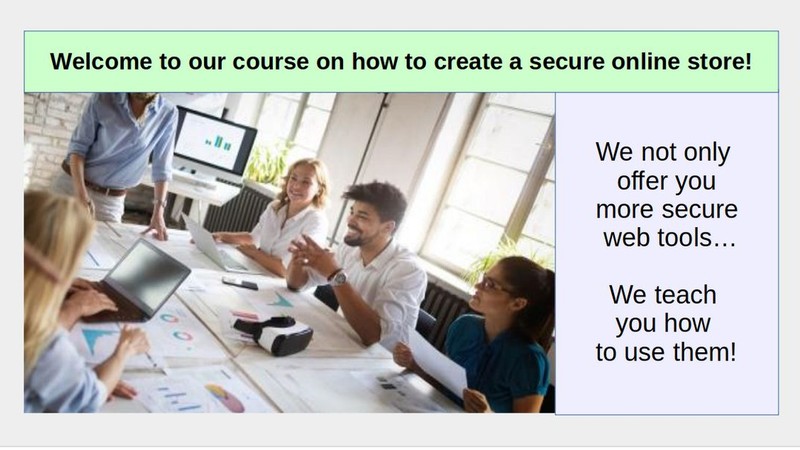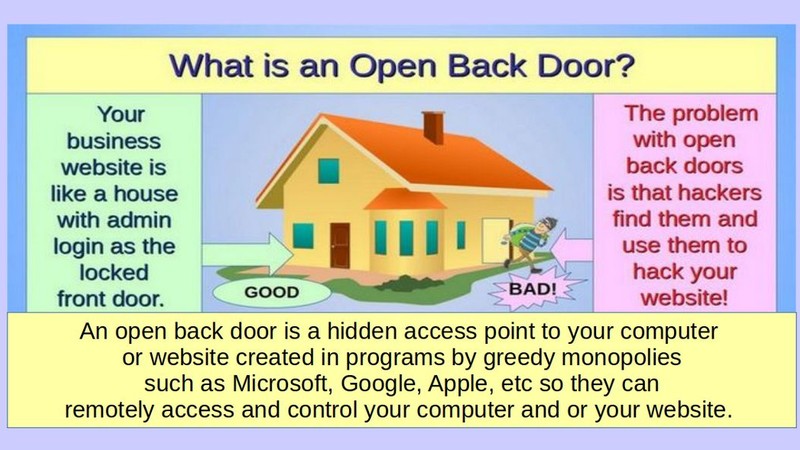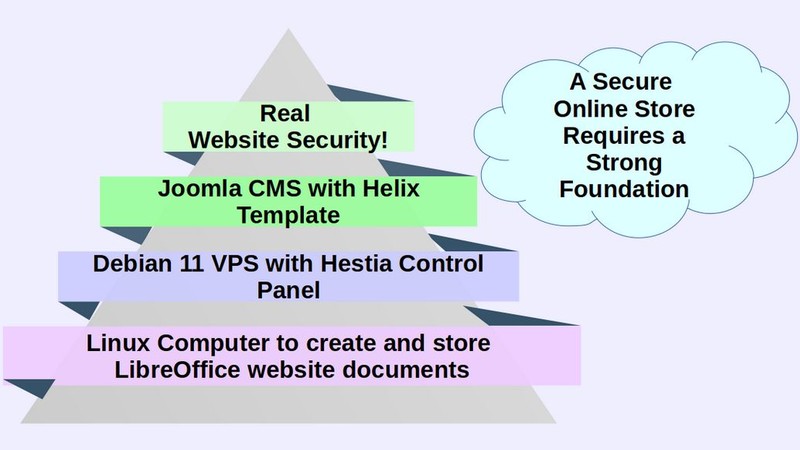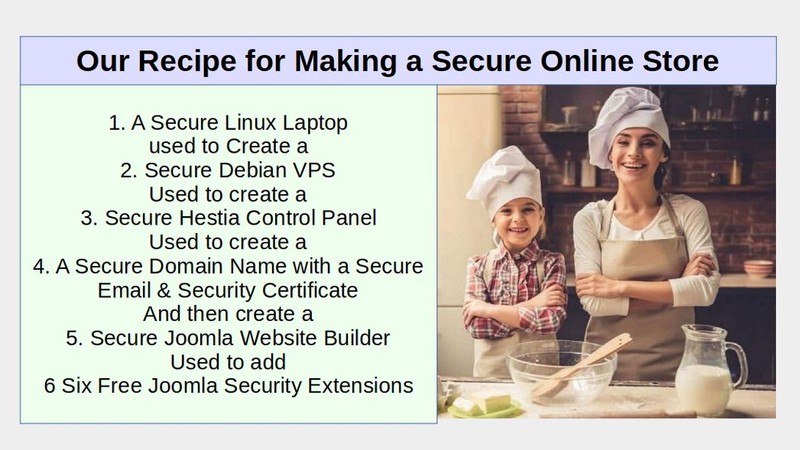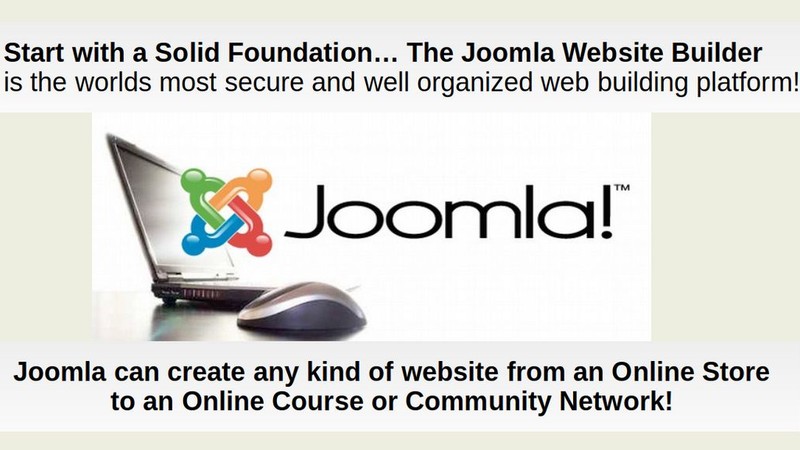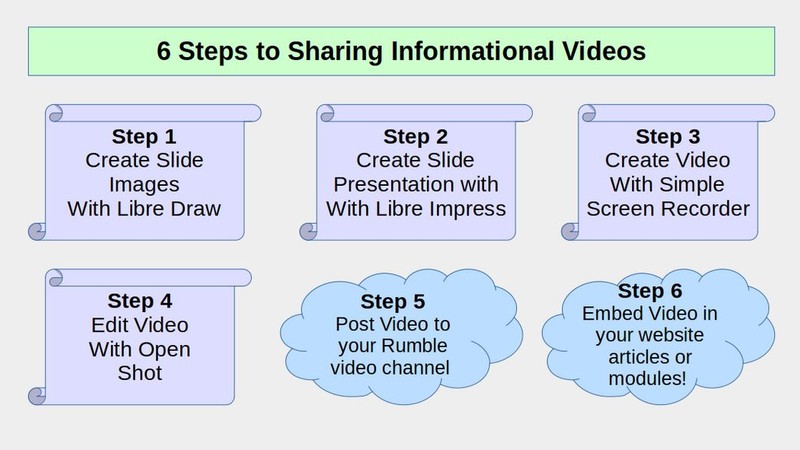Welcome to our website, book and course on how to build a secure online store! Our goal in this course is to help you create your own secure online store using free open source web building tools. While the cost of a traditional brick and mortar store can be more than $2,000 per month, an online store can be as little as $20 per month. Even better, your customer base is expanded from your local area to the entire world!

However, there is a huge drawback to starting an online store. The Internet is currently a Hacker Heaven. Hackers seek out and attack online stores – costing business owners BILLIONS OF DOLLARS every year.
Business owners may work years to build their online store – not knowing that their business website can be destroyed in a matter of minutes by leaving an “open back door” for the hacker to take over their site. We therefore spend more time than any previous web building course describing how to prevent these open back doors.
We cover not only several free tools to add to your business website to make it more secure, but also how to secure the computer you use to build your website and how to obtain a secure server to host your online store. Our goal is to change the way business websites are built by providing you with a better, more secure way to build your online store.
We developed this course because the current options for building business websites are either too easy to hack (Wordpress) – too complex to manage (Magento) – or too expensive for most small business owners to afford (Shopify). They all involve vendor lock in and many saddle small business owners with huge hidden fees.
Business websites are different from personal websites because business websites include a database which contains important financial information. Insecure business websites are a prime target of hackers who use flaws in your business website to gain access to your business database, bank records and financial information. We don’t just help you build a professional looking business website, we help you avoid business-killing Ransomware attacks!

Our mission is to help you create your own successful online business using a new generation of free open source web building tools. These free tools include the Hestia Control Panel, Joomla 4 web building framework and Phoca Cart.

Open source means the source code, or software, is free and can be shared by anyone with anyone for any purpose. Open source is like a library...free and open knowledge shared with the community for the common good. No patents, no hassles, no barriers, no limits!

What about just hiring a consultant to build your online store website for you?
The traditional system for commercial businesses has been to hire a staff of consultants to build and run their websites. This system of farming out your website to computer programmers works well for larger corporations that have the funds to hire a full time technology staff. But this top down approach does not work well for small business owners and organizations who cannot afford to hire consultants.

The problem with outsourcing your website is that even the simplest of changes requires hiring a consultant familiar with computer programming for a fee of hundreds to thousands of dollars. If you want to send your customers a newsletter, that is another thousand dollars per year. If you want to set up a virtual shopping cart, that is another thousand dollars. If you want to set up a virtual shopping cart, that is another thousand dollars. If you want to promote a new line of products or a new set of services, that is another thousand dollars. Even after spending thousands of dollars, business owners are too often left with an insecure website they cannot manage.

We have created a new and better path. We will teach you how to build a secure business website where you have full control over the appearance, content and function of your website without computer programming – simply by clicking on a series of buttons!

Join the Online Revolution!
There is an online revolution occurring in the world today. Businesses are increasingly selling their products and services online. Educational organizations are teaching courses online. Social organizations are building their communities online. Authors are selling their books online. Families are shopping and researching products online. The sharing of knowledge and ideas is increasingly occurring online. It has been estimated that more than one billion people now use the internet on a regular basis with total sales soon to exceed one trillion dollars! If you want your business to succeed, it is time to join this revolution.
With our books and courses, we are introducing real website security and full control over the appearance, content and function of your website – simply by clicking on a series of buttons! With our books and courses, you will be able to build your own secure business website to bring in new customers now and expand to accommodate growth in the future.
Here is a summary of our course:

Use a Linux computer to create secure LibreOffice documents. The use a Debian VPS and the Hestia Control Panel to create a Joomla website with a Helix template and Phoca Cart Online Store.

Here are more than 30 key benefits of our course on how to create a secure online store…
#1 We have Real Business Website Experience…
Our unique business website building process was created by David Spring M. Ed. David built one of the world’s first business websites in 1994. Since then, David has trained thousands of business owners how to build their own secure business websites.

David is an experienced teacher with a Masters Degree in Education and more than 20 years of experience teaching college level technology courses. With our unique step by step process, you get more than just a pretty website with an About Us page. You learn how to build a SECURE website that hackers can’t take down!
#2 We Cover Real Computer Security…
Website security begins with computer security. Hackers take over business websites by finding and using open back doors.

One of the main back doors hackers use take over your business website is by infecting insecure business computers with Windows Ransomware. The only way to avoid being a victim of Windows Ransomware is to use a Linux computer to build and run your business website. We therefore teach you how to create and use a secure Linux computer. People are surprised to learn that Linux is actually much easier than Windows!

We explain how hackers attack Windows computers and hide in insecure, closed source document programs like Microsoft Office.
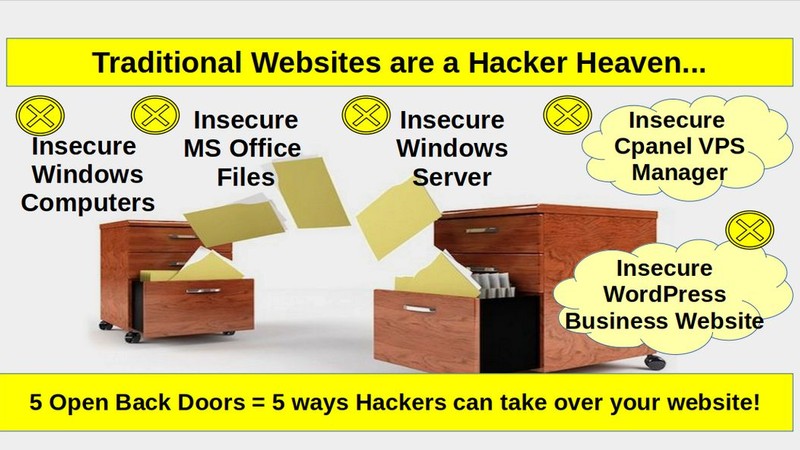
We then show you how to use free open source Word Processing and Image Editing programs such as LibreOffice to replace insecure, closed source programs.
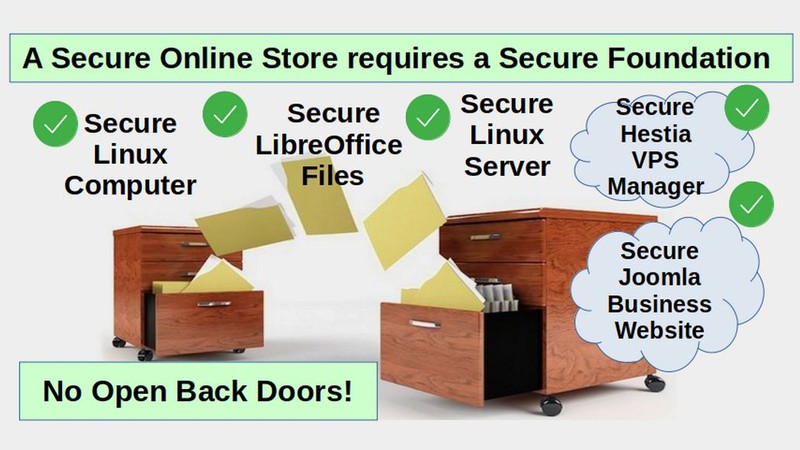
Proof that Linux and Joomla are much more secure than Windows and Wordpress
The US maintains a database called Mitre, of all reported computer and website security flaws (which are called computer vulnerabilities or CVE). In 2021, there were 1,126 Wordpress security problems compared to only 25 for Joomla. More important, while all 25 Joomla problems were fixed, many Wordpress flaws were never fixed!
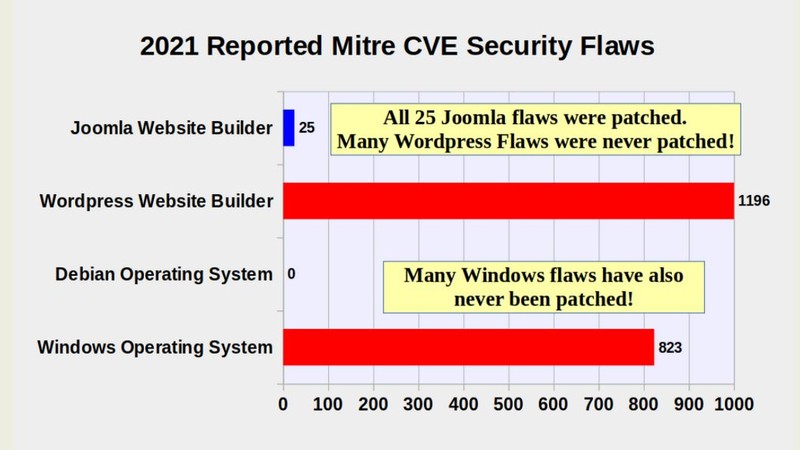
Also, the Windows operating system had 823 reported security flaws while the Debian Linux operating system did not have a single reported security flaw! This is why learning Linux and Joomla is essential for creating a secure online store!
In January, 2020, thousands of Wordpress business websites were hacked using a weakness in a PayPal form plugin. Hackers took over these sites and directed users to pages filled with malware. Hackers even set up a fake version of the Wordpress Plugins Directory which would download fake Wordpress Plugins filled with malware – allowing the hackers to take over even more Wordpress websites.
As yet another example of how insecure Wordpress is, here is a September 6, 2020 article describing an attack on “millions of Wordpress sites”:
https://www.zdnet.com/article/millions-of-wordpress-sites-are-being-probed-attacked-with-recent-plugin-bug/

Hackers upload a malicious image file through a Wordpress plugin. The image file then executes hidden code allowing the hacker to completely take over infected Wordpress websites.
Even if your Woo Commerce site is not hacked, all Wordpress business websites wind up becoming a disorganized mess over time due to Wordpress missing important essential features such as Image Category Management, Menu Item Type Management and User Access Control Levels. I have personally helped countless hacked Wordpress and Woo Commerce business website owners replace their hacked and hopelessly disorganized Wordpress sites with much more secure Joomla websites.
#3 We show you how to build a secure foundation…
Real website security requires a secure foundation. This includes not only using a Linux computer and LibreOffice to create your website documents but also using a Linux Server with a Hestia VPS manager to host your business website. Hestia Control panel offers many advantages over Cpanel:

#4 We use many more images
The first thing you will notice as you go through our course is the huge number of images. Our course has over 400 images – ten times the number in a traditional course on building websites.

Many of these images are useful in helping you see what the screens should look like when you are building your own website. Other images are intended to promote multi-modal learning. While some students learn best by reading words, others learn best by looking at images. Images have been vastly under-rated both in books and on websites. The human brain has learned from written words for less than two thousand years. But learning from images goes back millions of years and is deeply embedded in the human brain. There are web building books with page after page of text and almost no images. Such text intensive books make learning web building harder than it needs to be. Books and websites should devote much more space to images than they currently do. In this book and on our website, we are trying to set a good example. Later in this course, we will show you how to add and organize images for your own website.
#5 We use simple Click Here buttons, not complex computer programming.
We won’t overwhelm you with complex computer programming. We will do our best whenever possible to stay away from technical computer jargon. Instead of computer slang, we use plain English.

A common problem with many website building books is that they are written by computer programmers who usually have no background in Education or Learning Theory.
It is often difficult for programmers to explain concepts and tasks in non-technical terms. In our course, we try hard to stay away from computer programming and its convoluted jargon. Instead of complex computer programming, we build our website by clicking on buttons. Our focus is on meeting the needs of people who have no background in computer programming. We understand the importance of organizing information into small chunks to ensure that you can become a confident website builder.
#6 We use a Step by Step approach to Website Construction
In our course, we break down complex tasks into a series of simpler tasks. Too often, traditional web courses are presented in an almost random fashion which only confuses readers. We present topics in the order that they are needed to build a secure website. Another problem with traditional Joomla courses is that there are huge gaps in the instruction with many important topics not covered at all. For example, all of your web pages should have lots of images. How to handle these images is barely touched on in most courses. We provide you with detailed instructions on how to organize, transfer, store and post images onto your website. Here are 5 Steps for Writing and Posting Articles with Images:

There are plenty of courses that claim to help you set up your business website in a matter of minutes. But a clear and complete set of instructions is always better in the long run than shorter but incomplete instructions.
#7 We provide you with a Flexible Template System…
A template controls the appearance and structure of your website. The Helix Ultimate template is a free, open source template that allows you to easily customize the appearance of every aspect of your business website. The Helix template also comes with a customizable Mega Menu allowing you to create an expandable main menu which in turn allows website visitors to quickly navigate to the area of the website they are most interested in.

Crucially, the Helix template also provides you with an easy way to add more rows of content to your website as your website products, topics and group membership grows. The Helix template framework also automatically create a mobile version of your website for shoppers looking at your online store from their mobile phones.

#8 We feature a secure Business Website Shopping Cart…
Whether your business is selling products or services, you will need to display your products and services in a way that makes it easier for customers to buy them. We teach you how to use one of the world’s easiest, most secure and most powerful shopping cart tools.

#9 Infinitely expandable...Add as many products as you want, from as many manufacturers as you want, and place them in as many categories as you want. Common categories include downloadable virtual products, books, videos, clothing, services, subscription memberships and anything else you can think of. Everything, including product images stay nicely organized into sortable tables. While most online stores turn into an ugly mess over time, we show you how to build a business website that organize products and images into easy to understand tables organized by categories to help you keep track of thousands of products, product images and web pages. You can assign products not only by descriptive categories, but also by brands and/or tag categories. For example, you can display a page for all Sale Items or all Holiday Special items.

#10 Infinitely adaptable...With each product, can assign short and long descriptions, videos, specifications, reviews, ratings, questions, tags and attributes like size and color.

#11 Many Product Information Options... You can help your customers better understand the benefits of your most unique and important products by creating a List of Features, Product YouTube video, Reviews and Related Products all of which will appear in a Tabbed section below the Product on the Product page. If a picture is worth a thousand words, then a promotional video for each of your product is worth a million words!

#12 Custom Product Tags and Labels… Create your own custom product tags and labels, such as Our Favorites, Super Deal, Holiday Special and On Sale – or whatever you want!

#13 Complete Order Tracking System... with automatic billing and a complete history of the status of each order…so that you (and your customer) can tell what is happening with any given order with just the click of a button.

#14 Full Control over your website, your data and your future… Many business owners make the mistake of handing over control of their business website to someone else. We show you how to create your own secure online store. You retain complete control over every aspect of your online business and have the ability to change any aspect of your online store at any time.

#15 Dramatically Lower Long Term Costs… Many business website building tools are loaded with huge hidden fees costing thousands of dollars per year. Sadly, the Ecommerce world is now burdened with millions of hacked Wordpress websites and hundreds of thousands of very expensive Shopify sites. We offer you a different option. You do not have to choose between an insecure Wordpress site or a over-priced Shopify site. If you are willing to put in some time, you can have an online store that is inexpensive and secure.

#16 Free Customizable Product Slideshow… Display featured products with titles, descriptions, links and Read More buttons!
#17 Product Questions Button
An Ask Questions button displayed next to products makes it easier for your customers to email you questions they may have about a product they are considering purchasing.
#18 Category and Product Page Custom Layout Plugins
If you want to create a Category and/or Page Layout that is different than the default settings, perhaps with different spacing or fonts or button colors, in the past, you would need to create a copy of your Shop template and add a custom CSS file. Custom Layout Plugins simplify this process by placing your custom CSS in a Phoca Cart plugin that you simply install and then select in Options, Display.
#19 Option to Display All Products on your Shop Home Page
While the default Home page layout consists of a Featured Products Slideshow followed by a Welcome Article and a Grid Display of Product Categories, shops with only a few products can choose to simply display all of their products directly on their Shop Home Page.
#20 Automatic Image Resizing… Upload just the product image and Phoca Cart automatically creates all needed thumbnail images.
#21 Customer Wish Lists… Your customers can add their favorite products to a Wish List for future purchase.
#22 Product Comparison Tool… Customers can do side by side comparison of selected products.
#23 Customer Review and Rating System… Your customers can review and/or rate their purchased products.
#24 Product Search Function…. Customers can search for products by product category, product name or product brand.
#25 Virtual Product Selling System… allows you to sell virtual products such as Ebooks and Programs in addition to physical products such as shirts and hats.
#26 Automatic Inventory Control… An important key to the long term success of any business is inventory control. We provide you with an adjustable workflow tied to both vendor and customer orders. This workflow automatically increases inventory each time a product enters your system and automatically reduces the inventory each time a product is sold. You can even automatically notify customers when a product is back in stock!

#27 Fully configurable tax assignment for different tax structures and tax regions. Prices can include or exclude tax.
#28 Fully configurable shipping options Offer a variety of ways to have products shipped including USPS, UPS, FedEx with shipping prices ranging from free to price by weight, size, quantity, etc.
#29 Unlimited customer and vendor groups. You can display different products and prices depending on the customer group viewing the web page. Each customer can control their own optional user account. Ideal for club membership websites or websites selling products from many different vendors. However, customers also have the option of buying products without setting up an account.
#30 Phoca Cart supports nearly all credit card processing gateways including Stripe and PayPal. Phoca Cart even has the ability to submit payment using a unique Point of Sale system. This means you can use the same point of sale system for selling goods online and in your retail store – simplifying your bookkeeping system.
#31 Integrates with many other Joomla free web building tools such as free forum, slideshow and video display tools. There are more than one thousand free tools to customize a Phoca Cart store.
#32 Business Email Newsletters… With most business email newsletter tools, someone else controls your customer email database and you wind up paying huge monthly fees just to stay in touch with your customers. We provide you with a free email newsletter tool that allows you to keep direct control over your customer database. Equally important, you retain full control over the appearance and timing of your customer newsletters… giving you complete freedom to send customers newsletters.

#33 Lots of ways to get help. Both Joomla and Phoca Cart offer free friendly online forums where you can ask questions about technical issues.
#34 Joomla combined with Phoca Cart is the best foundation for your online store.
No other online store building tool at any price offers this combination of freedom, functionality, and versatility. Amazingly Phoca Cart is free! All you have to invest is the time it takes to learn how to use it. Many business owners spend years building their online store. With Joomla and Phoca Cart, you are building your online store on a solid and secure foundation.
Past, Present and Future of Ecommerce
When I made my first posts to the Internet, in about 1990, there were no online stores. In fact, using the Internet for commercial reasons was illegal. The Internet was only used by major Universities – who used the Internet to share ideas and documents in plain text over phone lines. I recall the first time I saw an HTML formatted page – and shortly thereafter – the first image posted to the Internet in 1991. Also in 1991, the government lifted its restriction on commercial use of the Internet. A few months later, the World Wide Web was opened to the public. But even though online stores were now legal, it did not make sense for stores to go to all the trouble of building an online store – because almost no one was using the Internet.
The first commercial website, books.com, made the first online transaction in August, 1994. I remember 1994 as I and some of my students and staff spent several months building another one of the very first online stores. It was just a catalog of our products. If a customer wanted to buy something, they still needed to give us a call and we would process their payment and mail it to them.
The reason I had a front row seat to the beginning of Ecommerce was that I owned a store located less than one mile from Microsoft in Redmond Washington. Many of my loyal customers were Microsoft employees. In addition, I taught courses at Bellevue College – which was the closest college to Microsoft. Many of students were Microsoft employees. These computer programmers were also my friends. They asked me if they could build an online version of our store as a Demonstration Project for a new program they were making at Microsoft. The program eventually became Front Page.
In July 1995, another online store called Amazon started just months after my own online store. Amazon was also located in Bellevue within a couple of miles of my store and a couple of miles of Bellevue College where I helped train some of Amazon’s earliest employees. Here is the 1995 Amazon Home page:

Over the next few years, it seemed like the entire US moved online. I helped numerous businesses create an online presence. Only a few of these businesses actually sold products online. Mainly, they just displayed products and listed their Store Hours and Phone number.
By 2014, the Internet passed 3 billion users.

US Ecommerce sales have grown steadily, with online sales now accounting for about 20% of total sales. This is double what it was just 5 years ago. And this is only the beginning.
The Good (Phoca Cart), the Bad (Woo Commerce) and the Ugly (Shopify)
The past 5 years have seen rapid change in the development of online stores. PHP, the primary computer language used to build online stores and control their databases, has seen massive improvements in security. Joomla also has seen massive improvement. Joomla 2.5 was retired in 2015 and replaced by Joomla 3 – which has seen 23 revisions. Joomla 4 was started in 2017. After years of development, Joomla 4 was released in August 2021.
Phoca Cart was added to the Joomla Extensions Directory in October 2017. Since then, Phoca Cart has undergone extremely rapid development with many new features added every few months.
But while PHP, Joomla and Phoca Cart have undergone major rapid improvements, other popular shopping cart options have gotten much worse. Wordpress and its shopping cart, Woo Commerce, have become a Hacker Heaven. The problems with Wordpress are structural and ongoing. Here is a September 6, 2020 article describing an attack on “millions of Wordpress sites”:
https://www.zdnet.com/article/millions-of-wordpress-sites-are-being-probed-attacked-with-recent-plugin-bug/

Even if your Woo Commerce site is not hacked, all Wordpress business websites wind up becoming a disorganized mess over time due to Wordpress missing important essential features such as Image Category Management, Menu Item Type Management and User Access Control Levels. I have personally helped countless hacked Wordpress and Woo Commerce business website owners replace their hacked Wordpress sites with much more secure Joomla websites. But Wordpress has given open source website building tools such a bad name that many businesses owners have gone from one bad option (Wordpress) to the opposite extremely bad option – a very expensive business website building tool called Shopify.
How Expensive is Shopify?
When you are starting a new online store, the first few years are the hardest because it takes time to build up a loyal customer base. During these first tough years, every dollar counts. Shopify claims to offer a “starter” plan that only costs $30 per month. But in fact, there are tons of hidden additional costs involved in starting and running a Shopify store. So let’s see how much Shopify really costs.
Shopify claims to offer three plans running from $29 per month to $299 per month. If you want a Point of Sale System to combine online and in-person sales that is another $90 per month. There is also a more hidden plan called Shopify Plus which starts at $2,000 per month and goes up from there. Then there is the cost of Shopify apps. One online survey indicated that the average Shopify Store Owner pays $100 or more per month for additional apps not included in the basic package. Here are just some of the common apps that charge monthly fees: Backups $30, Product Reviews $30, Bulk Product Edit $20, Custom Theme, $20, Custom Fields $20, Product Search $20. Shipment Tracker $30. Plus Shopify takes a percent of your sales (in addition to your normal payment gateway fees):

So let’s say you run a typical in-store and online business doing about $100,000 per month. It may sound like you are making a lot of money and can afford whatever Shopify is charging. But after paying for the Products, Staff, Accounting, Insurance and Promotion, you will be lucky to make a net profit of 5%. So on your $100,000 in sales, you might make only $5,000 in actual profit. And if Shopify is taking a 5% cut on all of the purchases, then your profit drops to zero and soon you are out of business! So much for the $30 per month plan.
There are similar hidden costs for most other shopping carts. For example, Magento claims to be free. But if you need support, the Enterprise Edition is $2,000 per month or $24,000 per year.
Compare this to Phoca Cart which gives you many more features and costs almost nothing. $20 per month covers both domain name and hosting. Joomla is free. Phoca Cart is free. Nearly all of the Joomla and Phoca Cart apps are free. Plus you get a website that is much more secure than Shopify thanks to open source auditing of the code. And you control your data – not Shopify.
What will the Future of Ecommerce Websites Be?
Sadly, due to a lack of research by new online store owners into the drawbacks of Woo Commerce and Shopify, the Ecommerce world is now burdened with millions of hacked Wordpress Woo Commerce websites and thousands of very expensive Shopify sites.
The result is that most of these online startups will fail – leaving online customers with Mega Monopolies like Amazon as their only choice. Our goal is to change the direction of Ecommerce and create a better future for small business owners by providing a third way. You do not have to choose between an insecure Woo Commerce site or an over-priced Shopify site.
If you are willing to put in some time and effort, you can have an online store that is both inexpensive and extremely secure. The future of Ecommerce is in your hands.
Create a Secure Online Store Course Overview
This course consists of the following 9 sections.
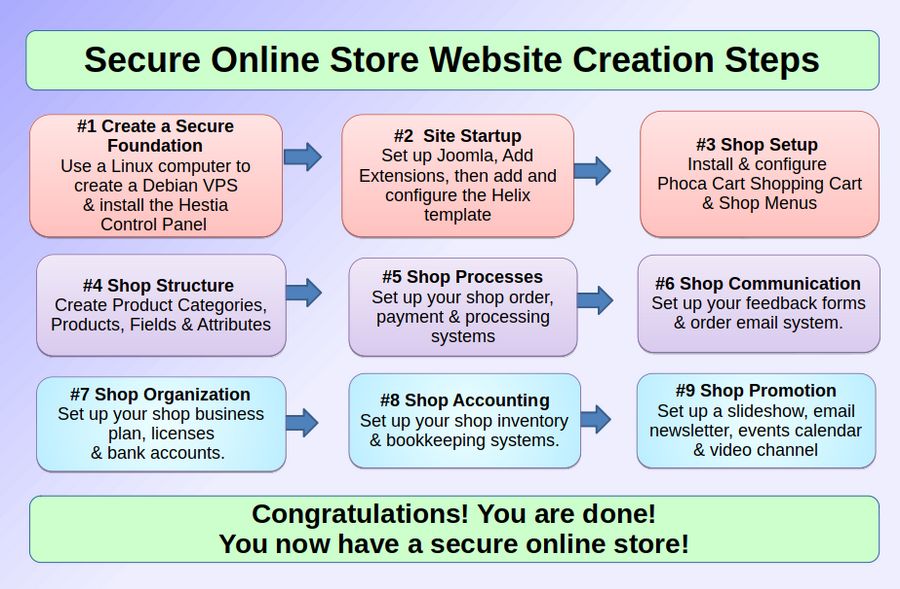
The first step in creating a secure online store is to start with a secure foundation. We begin by using a Linux computer to create and organize your business website documents. We then explain how to create a Debian VPS, how to install the Hestia Control Panel and use Hestia to install Joomla with a flexible template called Helix. We then cover how to install and configure Phoca Cart and add Product categories and products. We then set up the Order Management System, and review shop payment and shipping methods. We conclude the by outlining shop management, accounting and promotion tools.
What’s Next?
The first step in building a Phoca Cart store is building your Linux computer. That is the topic of the our first lesson. Are you ready to take your online business to the next level? Let’s get started!


